When you first arrive in Thailand, you’ll quickly discover that cash is king, especially coins. From buying street food for 35 baht to feeding exact change into BTS Skytrain machines, understanding Thai coins is essential for any visitor. But for first-time tourists, these gleaming pieces of metal can seem like a confusing puzzle. Which is the 5 baht coin? Why do some 2 baht coins look different? And what on earth is a “satang”?
This comprehensive guide will transform you from a confused tourist fumbling through your wallet into a confident traveler who can identify Thai coins at a glance.

‘ChooChai’ Boonsrangjamrus
Tour Guide License No. 1-017815
Understanding Thailand’s Coin System
Thailand uses the Thai Baht (THB) as its currency, with coins playing a crucial role in daily transactions. The coin system consists of six denominations: 25 satang, 50 satang, 1 baht, 2 baht, 5 baht, and 10 baht. Here’s the key: 100 satang equals 1 baht, making satang coins the “cents” of Thai currency.

According to Thai law, there’s a limit to how many coins you can use at once, for example, you can only use satang coins up to a maximum value of 10 baht per transaction. This explains why many vendors prefer to round prices to the nearest baht.
The Big Coins: Easy Identification for Beginners
10 Baht Coin: The Distinctive Two-Tone Giant
The 10 baht coin is impossible to miss, it’s the largest coin in circulation at 26mm diameter. This distinctive coin features a silver-color ring with a brass-color center, making it bimetallic and easily recognizable. The reverse side showcases Wat Arun (Temple of Dawn) in Bangkok, one of Thailand’s most iconic landmarks. Many Europeans have noted that the 10-baht coin is “close in size and style to a $2 Euro,” which can be a helpful reference point.
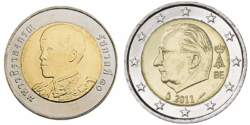
Tourist Tip: This coin replaced the 10 baht banknote in the early 1990s, so you won’t see any 10 baht bills in circulation.
5 Baht Coin: The Silver Standout
The 5 baht coin measures 24mm, making it slightly smaller than the 10 baht coin. It has a fully silver-colored finish. The reverse features Wat Benjamabophit, also known as the Marble Temple. Many American tourists have noted that the 5 baht coin is “close in size to a US quarter,” which can be a helpful reference point.
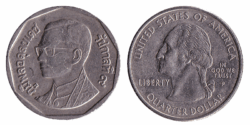
The Tricky Middle: Coins That Confuse Tourists
2 Baht Coin: The Shape-Shifter
Here’s where things get interesting, and confusing. The 2-baht coin appears in both gold and silver, depending on the year of minting.
The Mint switched to a brass-colored design after 2005, adding an image of the Golden Mountain at Wat Saket in Bangkok.
The original 2005-2007 version was silver-colored and looked remarkably similar to the 1-baht coin. This similarity was so problematic that many people use a permanent marker to write the number “2” on these coins to prevent mix-ups.
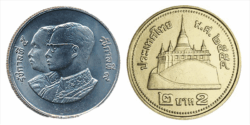
Tourist Alert: Some older ticket vending machines (BTS Skytrain, MRT Metro, Airport Rail Link) cannot accept 2 baht coins, so keep this in mind when using public transport.
1 Baht Coin: The Silver Standard
The 1 baht coin measures 20mm across, has a silver color, and shows the chedis (spires) of the Temple of the Emerald Buddha on the back. You’ll use this coin most often for small purchases and tips.
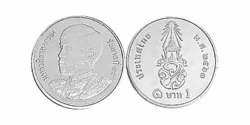
The Tiny Ones: Satang Coins Most Tourists Ignore
50 Satang: The Copper Half
The 50 satang coin is copper colored and worth half a baht (about 1.5 cents USD). At 18mm diameter, it features the chedi at Wat Prathat Doi Suthep in Chiang Mai. These coins are mostly used in supermarkets and convenience stores like 7-Eleven.
25 Satang: The Tiny Brass Coin
The smallest coin at just 16mm, the 25 satang piece is brass-colored and worth about a quarter of a cent USD. Many street vendors won’t accept these coins, so don’t be surprised if they’re refused.
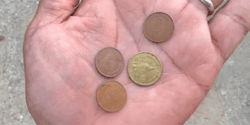
Quick Identification Tricks for Tourists
Size Order (Largest to Smallest):
- 10 baht (26mm) – Two tone, unmistakable
- 5 baht (24mm) – All silver color
- 2 baht (21.75mm) – Brass or silver depending on age
- 1 baht (20mm) – Silver color
- 50 satang (18mm) – Copper color
- 25 satang (16mm) – Tiny brass color
Color-Coding System:
- Two-tone (silver + brass): 10 baht
- All silver: 5 baht and 1 baht (and old 2 baht)
- Brass/gold: New 2 baht and 25 satang
- Copper: 50 satang
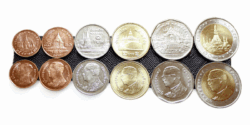
Cultural Considerations: Respecting Royal Currency
Every Thai coin features the image of the King, making proper treatment essential. It’s considered offensive to carry money in your back pocket, as this means sitting on the King’s image. Additionally, never step on coins or treat them disrespectfully.
Practical Tips for Smooth Transactions
- Stock up on small coins: Public transport ticket machines primarily accept coins (10, 5, and 1 baht), so always carry these denominations.
- Satang strategy: Many vendors round prices to the nearest baht, so use your satang coins at supermarkets or 7-Eleven stores where they’re more likely to accept them.
- Temple coins: Each coin showcases a different famous Thai temple, making them educational souvenirs that tell stories of Thailand’s rich Buddhist heritage.
- Machine compatibility: Be aware that older vending machines may not accept certain coins, particularly the silver 2 baht coins from 2005-2007.
Conclusion: From Confusion to Confidence
Mastering Thai coins isn’t just about making transactions, it’s about showing respect for Thai culture and navigating daily life with confidence. Start by focusing on the big three: the distinctive two-tone 10 baht, the silver 5 baht, and the essential 1 baht coin. Once you’ve mastered these, the smaller denominations will follow naturally.
With this guide in hand and a little practice, you’ll quickly start handling Thai coins like a local. Everyday transactions will feel easier, and your Thai adventure will run more smoothly. In fact, before long, you’ll be confidently counting out exact change. You might even impress locals with your growing confidence and coin know-how.
